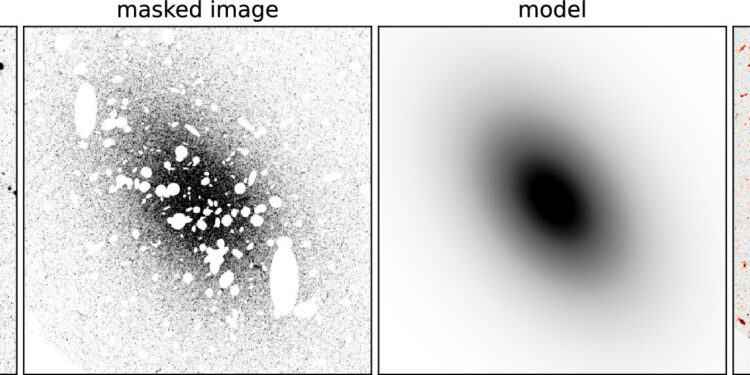FCC 224 g475 Image as an example of our galfit modeling. From left to right, the three panels show the original image, masked image, model and residues. The images shown here have sizes of 3 times the Re of FCC 224, while real input images to Galfit include the entire Uvis chip (∼155 ”× 75 ”). Credit: The astrophysical newspaper (2025). DOI: 10.3847 / 1538-4357 / ADAE11
Astronomers using the WM Keck Observatory on Maunakea, Hawaiʻi Island, have found convincing evidence of a dwarf galaxy deficient in dark matter, FCC 224. This ultra-diffuse galaxy is located on the outskirts of the Cluster Fornax, around 60 to 65 million light years of light years.
The discovery questions the traditional cosmological paradigm, which assumes that dark matter is a fundamental component of the formation of galaxy. Previously, the galaxies deficient in dark matter without any training of stars in progress had been claimed in another place, the NGC 1052 group, and the new observations suggest that such objects can be more widespread than we thought before.
The unusual galaxy was profiled in two additional studies. The first study, led by the candidate for the doctorate Yomemeg Tang of the University of California in Santa Cruz and published in the Astrophysical JournalAnalysis The CLUSTER GLOBULAR SUBLUS SUPPLICATION SUBLULAR GLUBLAR FCC 224.
The second, led by doctoral candidate Maria Luísa Buzzo from Swinburne University and the Southern European Observatory, and published in Astronomy and astrophysicsExplore the content of the dark matter of the galaxy and possible scenarios for its training.
“Globular clusters are often used as an indirect indicator to estimate the amount of dark matter that a galaxy contains,” said Buzzo. “For any reason, this galaxy (FCC 224) has an unusual number of light clusters and no dark matter, at least in its interior regions. No model of galaxy formation existing in our standard cosmological paradigm can currently be explained how this galaxy was born.”
Buzzo’s research has studied the black matter content of the FCC 224 using high resolution spectroscopy of Keck Observatory Keck Cosmic Imaging (KCWI). She explored her similarities with dwarf galaxies without black matter previously claimed DF2 and DF4, located in the Galaxy NGC 1052 group, to determine whether FCC 224 belongs or not to the same class of galaxies.
Buzzo’s search is based on Tang’s first results, which, using the imaging of the NASA Hubble Space Telescope (HST), found that FCC 224 has clusters of stars similar to other galaxies deficient in black matter. Their research suggests that these types of star clusters can be linked to a lack of dark matter, which questions conventional models for galaxies. The data from the Keck / KCWI Observatory were obtained through a proposal from the Swinburne University under the Duncan Forbes main investigator (PI), while HST data was acquired through a program led by PI Aaron Romanowsky.
“KCWI’s new high resolution red arm has allowed us to measure the movements of the galaxy very precisely, which can be used to draw its content of dark matter,” said Buzzo. “The high spectral resolution of KCWI allowed us to precisely measure the movements (speed dispersion) in the stars and the globular clusters of the FCC 224,” said Tang. “These measures have confirmed that the galaxy has an extremely low speed of speed – a characteristic of a deficiency in dark matter.”
The two teams highlight the need for new observations to understand the mechanisms of the FCC 224 formation. A main hypothesis is that an external interaction, such as a high-speed collision, can have separated the dark and visible material from the galaxy, a training scenario known as the “bullet-darf model”. However, additional data is necessary to test this theory.
“FCC 224 serves as a crucial data point in our efforts to identify and study other galaxies deficient in black matter,” added Buzzo. “By widening the size of the sample, we can refine our understanding of these rare galaxies and the role of dark matter in the formation of dwarf galaxies.”
The discovery of FCC 224 outside the NGC 1052 group suggests that the galaxies deficient in dark matter can be more common than we thought before, which raised fundamental questions about the need for dark matter in the formation of galaxies. As observation capacities improve, astronomers aim to conduct greater investigations to identify similar galaxies and study their origins.
More information:
YIMENG TANG ET, an unexplained origin for the unusual globular cluster system in the ultradiffuse Galaxy FCC 224, The astrophysical newspaper (2025). DOI: 10.3847 / 1538-4357 / ADAE11
Maria Luisa Buzzo et al, a new class of dwarf galaxies without black matter ?, Astronomy and astrophysics (2025). DOI: 10.1051 / 0004-6361 / 202453522
Supplied by the WM Keck observatory
Quote: Proof of dwarf galaxy without dark matter questions the training models of conventional galaxies (2025, April 15) recovered on April 15, 2025 from
This document is subject to copyright. In addition to any fair program for private or research purposes, no part can be reproduced without written authorization. The content is provided only for information purposes.



